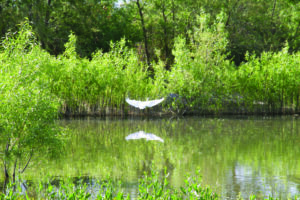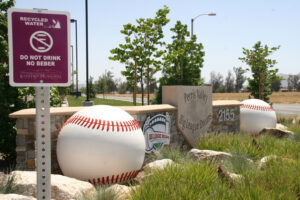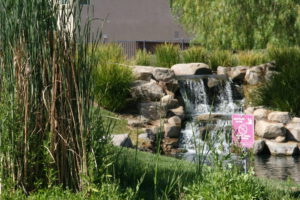Eastern Municipal Water District (EMWD) provides water, wastewater, and recycled water service to more than 825,000 people in Riverside County, California. Since the 1960s, the district has been supplementing its largely imported water supply by developing wastewater reclamation and recycling projects. Currently, recycled water represents about 34 percent of its portfolio and is delivered to agricultural, industrial, institutional, and environmental users.
In this interview, Joe Mouawad, assistant general manager of EMWD, speaks with Municipal Water Leader Managing Editor Joshua Dill about how EMWD’s recycled water is benefiting ratepayers and the local environment as a whole.
Joshua Dill: Please tell us about your background and your role in EMWD’s water reuse programs.

Joe Mouawad: I serve as the assistant general manager of Planning, Engineering and Construction at EMWD. We are a retail and wholesale water agency serving a region spanning 555 square miles in western Riverside County. We provide water, wastewater, and recycled water services to a population of more than 825,000 people. Our service area includes seven cities as well as large portions of unincorporated Riverside County. One distinctive feature of this area is that it is only 38 percent built out. So there is a significant amount of growth yet to occur. We’re currently about 50 percent reliant on imported water supplies; the balance is provided from local resources, including recycled water. Recycled water currently represents approximately 34 percent of our water supply portfolio. Our primary recycled water customer is the agricultural community. It represents about 60 to 65 percent of our recycled water sales. Recycled water is also used for municipal and irrigation purposes in parks, schools, and golf courses; for industrial uses, including a power plant; and for environmental uses, including a local wildlife area. EMWD has invested significantly over the last two decades in the recycled water system. It is a pressurized system with elevated and seasonal storage as well as extensive transmission pipelines and pump stations to deliver recycled water to a diversified portfolio of customers.
Joshua Dill: How far back does your recycled water program go?
Joe Mouawad: Our wastewater treatment and reclamation system started back in the 1960s. Initially, we partnered with the agricultural community to dispose of the effluent from our reclamation facilities. That partnership has evolved over the decades. We currently operate four regional water reclamation facilities that produce tertiary treated water. Through the investments we have made in the system, our recycled water system has been transformed from a disposal system to a pressurized storage and distribution system. That has allowed us to expand our services from agricultural to other municipal and irrigation uses. Over the last 20 years, EMWD has invested approximately $200 million in infrastructure facilities, including regional seasonal storage, pump stations, pipelines, and elevated tanks. We have successfully secured external grant funding to help make those investments. The Bureau of Reclamation has been a key partner in the expansion of our recycled water system. We’ve also received significant support from the Metropolitan Water District of Southern California through its local resources program, which provides financial incentives to advance local resources, including recycled water. EMWD has also received funding from the California State Water Resources Control Board.
Joshua Dill: What is the total amount of recycled water that you provide?
Joe Mouawad: Our reclamation facilities currently produce approximately 44 million gallons per day of tertiary treated water. EMWD has the strategic goal of reusing 100 percent of all treated wastewater, and of the past 6 years, there have only been 2 years during which we had to discharge recycled water due to exceptionally wet winter seasons. This year was one of those exceptions: We filled up all our regional storage, about 7,500 acre-feet in all, and had to discharge approximately 6,000 acre-feet of recycled water.
Joshua Dill: Would you tell us about the wetlands project that EMWD has undertaken?
Joe Mouawad: The wetlands is a 50-acre site with approximately 26 acres of storage ponds that were constructed in 1994 with the assistance of a $7 million grant from Reclamation. It is adjacent to our San Jacinto Valley Regional Reclamation Facility. The initial purpose of the wetlands was to remove nutrients from the secondary effluent produced at the San Jacinto facility and to provide support for habitat. It also provided an opportunity for us to undertake educational programs and research. Since that time, the San Jacinto facility has been expanded and upgraded to produce tertiary treated water, which is used for the wetlands.
Today, we use the wetlands strictly for educational purposes. We have an educational center adjacent to the wetlands where we host a number of EMWD’s K–12 educational programs. This provides our educational staff the opportunity to highlight the water recycling process. We also have monthly bird walks during the height of birdwatching season to demonstrate the environmental benefits of the habitats that the wetlands provide.
Joshua Dill: What nutrients can wetlands remove from water?
Joe Mouawad: The water that had previously been provided to the wetlands was secondary treated water, which still had some residual nitrogen. The vegetation in the wetlands removed nitrogen from the secondary effluent.

Joshua Dill: How is recycled water used for agriculture?
Joe Mouawad: The agricultural community has been a key partner for EMWD over the last several decades. We currently sell or provide approximately 65 percent of our recycled water to agricultural customers. Within EMWD’s service area, recycled water is used to irrigate approximately 10,800 acres of farmland. In 2018, we provided 22,000 acre-feet of recycled water to agricultural customers. Our rate structure incentivizes the agricultural community to use recycled water in lieu of pumping from our precious groundwater supply. Some customers are able to store water onsite, while others are on-demand and need to peak off our system. In the winter, when our demands are typically lower, we have a lower rate for the agricultural community; we have worked with agricultural users so that their planting season coincides with the availability of recycled water in the winter.
The main challenge that we have overcome over the last two decades was maintaining a high level of service to our agricultural customers. Before we made additional investments in infrastructure, there were times when we were not able to maintain sufficient pressure or supply of recycled water. We had to significantly expand our ability to store water on a seasonal basis—meaning storing water during the winter, when demands are low, so that we can deliver it to our customers in the summer—with pump stations, pipelines, and elevated storage tanks, similar to those in a portable water system. Once we made those system improvements, with the assistance of Reclamation, the Metropolitan Water District of Southern California, and other partners, the level of service improved dramatically for all our customers, including our agricultural customers.
Joshua Dill: What industrial uses is the recycled water put to?
Joe Mouawad: Not far from EMWD headquarters is a power plant called the Inland Empire Energy Center. In 2007, we entered into an agreement to provide the facility with recycled water for its cooling towers. It uses that recycled water for multiple cycles before discharging it to our brine collection system.
Joshua Dill: What kind of requirements for water quality to do the industrial cooling plants have?
Joe Mouawad: The power plant requires disinfected, tertiary treated water. EMWD delivers tertiary treated water that is disinfected as part of the treatment process. All of EMWD’s recycled water is treated to the same quality.
Joshua Dill: Is recycled water put to any other uses that we haven’t covered?
Joe Mouawad: In addition to the wetlands, we support a significant wildlife area, the San Jacinto Wildlife Area, which is operated and maintained by the California Department of Fish and Wildlife. That facility currently uses about 4,300 acre-feet of recycled water per year. The partnership was established in

1989, when we made our first delivery. There are private duck clubs within the wildlife area that receive a significant amount of recycled water for their operations. We also provide recycled water to a significant number of schools and parks, including a partnership with another special district, the Valley-Wide Recreation and Park District. Finally, we have partnered with the cities in our area to convert irrigated medians and public rights of way to recycled water and to remove turf grass altogether in those areas to protect our precious water supplies and showcase water efficient landscapes.
EMWD has also advanced an accelerated retrofit program for recycled water over the last several years that allows entities like schools and parks to retrofit their onsite potable water landscape irrigation systems to recycled water without extensive upfront costs. Through this program, EMWD’s board of directors authorized staff to assist customers in the design and permitting of the retrofit. We also cover the cost of those retrofits and are reimbursed for those costs over a period of time through a special rate that is 75 percent of the potable water rate. That is higher than our typical recycled water rates, but still provides a 25 percent discount to the customer that completes the retrofit to recycled water. Customers see an immediate reduction in their water rates, and the retrofit cost is reimbursed to the district over a set period of time. It’s a win for everyone. In phase 1 of this program, we converted 460 acre-feet per year from potable to recycled water. We are now finishing phase 2 of that program. At the upcoming WateReuse conference, EMWD is being recognized for the success of our accelerated retrofit program.
Joshua Dill: What advice would you have to other municipal water districts that are considering implementing recycled water programs?
Joe Mouawad: A key component is the vision of the board of directors. Without that vision and without the board fully supporting all the different initiatives that we described, we would never have been able to succeed. Public outreach and education is also key for the success of a recycled water program. Another recommendation would be to have a very aggressive grants and loans effort.
Joshua Dill: What is your vision for the future?
Joe Mouawad: As we continue to grow as an agency, we’re going to have more available recycled water, and we are already thinking ahead about the best use for it. Therefore, EMWD is advancing a purified water replenishment program in which we would take advanced-treated recycled water and use it to recharge our groundwater basin.
Joe Mouawad is assistant general manager of planning, engineering, and construction for EMWD. For more information, please visit www.emwd.org.
